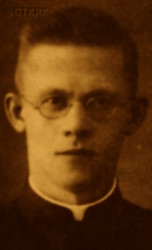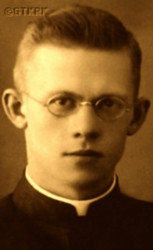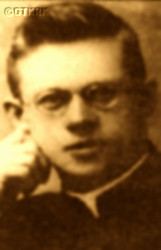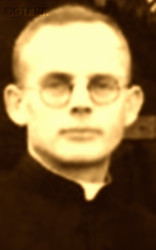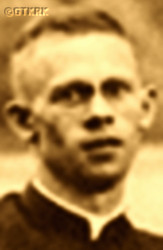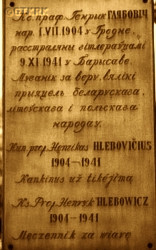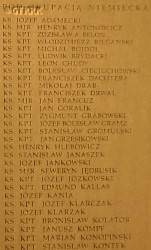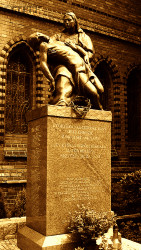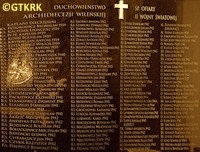Roman Catholic
St Sigismund parish
05-507 Słomczyn
85 Wiślana Str.
Konstancin deanery
Warsaw archdiocese, Poland
full list:
displayClick to display full list

searchClick to search full list by categories
wyświetlKliknij by wyświetlić pełną listę po polsku

szukajKliknij by przeszukać listę wg kategorii po polsku

Martyrology of the clergy — Poland
XX century (1914 – 1989)
personal data
religious status
blessed
surname
HLEBOWICZ
forename(s)
Henry (pl. Henryk)
beatification date
13.06.1999more on
www.swzygmunt.knc.pl
[access: 2013.05.19]

the RC Pope John Paul IImore on
en.wikipedia.org
[access: 2014.09.21]
function
diocesan priest
creed
Latin (Roman Catholic) Church RCmore on
en.wikipedia.org
[access: 2014.09.21]
diocese / province
Vilnius archdiocesemore on
en.wikipedia.org
[access: 2013.05.19]
academic distinctions
Doctor of Theology
Doctor of Philosophy
honorary titles
Gold „Cross of Merit”more on
en.wikipedia.org
[access: 2019.04.16]
(10.11.1938)
date and place
of death
09.11.1941

n. Barysawtoday: Barysaw dist., Minsk reg., Belarus
more on
en.wikipedia.org
[access: 2022.09.11]
details of death
In 1912/1913 his father — a Polish Catholic employee of the Peasant Agricultural Bank, and later a municipal treasury official in Grodno — was transferred/exiled to Orenburg on the Ural River after refusing to convert to Orthodoxy. There completed high school and passed the matriculation examination. To Grodno returned in 1921, after Poland had regained independence and Russia had been defeated in the Polish–Russian War of 1919‐1921.
After German and Russian invasion of Poland in 09.1939 and start of the World War II, took part in heroic defense on 20‐24.09.1939 of Grodno — from Russian barbarians, who resorted to tying captured Poles to their tanks and using them as shields — together with Fr Francis Potrzebski, Fr Francis Zakrzewski and Fr Innocent Guz, among others.
After Vilnius annexation by Lithuania in 09.1939, organiser and activist of Polish clandestine resistance „Peoples Action” (part of future Polish Clandestine State) under nom‐de‐guerre „Boleslav Szewik”, „Bolshevik”.
Editor and publisher — the printing took place in his apartment — of the clandestine „Polish tomorrow” (from 1941 „For Poland”) and „As long as we live” (for youth) magazines.
During Lithuanian, Russian and then German occupation an outstanding preacher being able to bring in all Vilnius youth, among others preacher of extraordinary sermon on 03.05.1941, few weeks after mass arrests of Polish clandestine Armed Struggle Union ZWZ activists in Vilnius region (part of Polish Clandestine State).
After German attack on 22.06.1941 of their erstwhile ally, Russians, went on 20.09.1941 east, beyond pre‐war Polish border, to minister to Catholics for more than 20 years persecuted in Russia.
There summoned to Pleszczenice station arrested on 07.11.1941 by Germ. Weißruthenische Hilfspolizei (Eng. Belarusian Auxiliary Police), collaborating with Germans.
Next day transported to Barysaw police jail.
From there the following day driven out in unknown direction.
Prob. murdered by Belarusians (according to some sources handed in to Germans and then murdered) in the forest n. Barysaw.
cause of death
murder
perpetrators
Germans / Belarusians
sites and events
Ribbentrop‐MolotovClick to display the description, Pius XI's encyclicalsClick to display the description
date and place
of birth
01.07.1904

Grodnotoday: Grodno dist., Grodno reg., Belarus
more on
en.wikipedia.org
[access: 2023.01.18]
parents
HLEBOWICZ Francis
🞲 1875, ? — 🕆 14.12.1940/1941, Grodnotoday: Grodno dist., Grodno reg., Belarus
more on
en.wikipedia.org
[access: 2023.01.18]

CHREPTOWICZ Hedwig
🞲 1880, Grodnotoday: Grodno dist., Grodno reg., Belarus
more on
en.wikipedia.org
[access: 2023.01.18] — 🕆 1972, ?
presbyter (holy orders)
ordination
20.02.1927

Lublintoday: Lublin city pov., Lublin voiv., Poland
more on
en.wikipedia.org
[access: 2021.08.20]
positions held
1941
administrator — Chotajewiczetoday: Oktyabr, Oktyabr ssov., Lahoysk dist., Minsk reg., Belarus
more on
be.wikipedia.org
[access: 2023.01.18] ⋄ St Dominica RC parish ⋄ Barysawtoday: Barysaw dist., Minsk reg., Belarus
more on
en.wikipedia.org
[access: 2022.09.11] RC deanery ⋄ Minsk RC diocese ⋄ Mogilev RC archdiocese
1941
administrator — Korentoday: Gaina ssov., Lahoysk dist., Minsk reg., Belarus
more on
be.wikipedia.org
[access: 2022.01.06] ⋄ Assumption of the Blessed Virgin Mary RC parish ⋄ Barysawtoday: Barysaw dist., Minsk reg., Belarus
more on
en.wikipedia.org
[access: 2022.09.11] RC deanery
1941
administrator — Okolovotoday: Okolovo ssov., Lahoysk dist., Minsk reg., Belarus
more on
be.wikipedia.org
[access: 2022.01.06] ⋄ St Michael the Archangel RC parish ⋄ Barysawtoday: Barysaw dist., Minsk reg., Belarus
more on
en.wikipedia.org
[access: 2022.09.11] RC deanery
1939 – 1941
vicar — Vilniustoday: Vilnius city dist., Vilnius Cou., Lithuania
more on
en.wikipedia.org
[access: 2022.01.06] ⋄ St Francis and St Bernard RC parish ⋄ Vilniustoday: Vilnius city dist., Vilnius Cou., Lithuania
more on
en.wikipedia.org
[access: 2022.01.06] RC deanery
1938 – 1939
prefect — Rabkatoday: Rabka‐Zdrój, Rabka‐Zdrój gm., Nowy Targ pov., Lesser Poland voiv., Poland
more on
en.wikipedia.org
[access: 2021.06.07] ⋄ St Therese Sanatorium's gymnasium for Women — during tuberculosis treatment
1935 – 1939
parish priest — Trakaitoday: Trakai eld., Trakai dist., Vilnius Cou., Lithuania
more on
en.wikipedia.org
[access: 2022.01.06] ⋄ Visitation of the Blessed Virgin Mary RC parish ⋄ Trakaitoday: Trakai eld., Trakai dist., Vilnius Cou., Lithuania
more on
en.wikipedia.org
[access: 2022.01.06] RC deanery
1930 – 1936
professor — Vilniustoday: Vilnius city dist., Vilnius Cou., Lithuania
more on
en.wikipedia.org
[access: 2022.01.06] ⋄ Department of Theology, Stephen Batory University [i.e. Vilnius University (from 1945) / some faculties acting clandestinely (1939‐1945) / closed by Lithuanians (1939) / Stephen Batory University (1919‐1939)] — lecturer in fundamental theology
1930 – 1936
professor — Vilniustoday: Vilnius city dist., Vilnius Cou., Lithuania
more on
en.wikipedia.org
[access: 2022.01.06] ⋄ Theological Seminary — lecturer in philosophy and fundamental theology, among others
c. 1930 – c. 1939
membership — Vilniustoday: Vilnius city dist., Vilnius Cou., Lithuania
more on
en.wikipedia.org
[access: 2022.01.06] ⋄ Lat. „Consilium rerum liturgicarum, cantus ac musicae sacrae” (Eng. „Liturgy, choirs and sacred music committee”), Archdiocesan Curia
c. 1930
vicar — Vilniustoday: Vilnius city dist., Vilnius Cou., Lithuania
more on
en.wikipedia.org
[access: 2022.01.06] ⋄ St Francis and St Bernard RC parish ⋄ Vilniustoday: Vilnius city dist., Vilnius Cou., Lithuania
more on
en.wikipedia.org
[access: 2022.01.06] RC deanery
1929 – 1930
vicar — Vilniustoday: Vilnius city dist., Vilnius Cou., Lithuania
more on
en.wikipedia.org
[access: 2022.01.06] ⋄ All the Saints RC parish ⋄ Vilniustoday: Vilnius city dist., Vilnius Cou., Lithuania
more on
en.wikipedia.org
[access: 2022.01.06] RC deanery
1928 – 1929
chaplain — Rometoday: Rome prov., Lazio reg., Italy
more on
en.wikipedia.org
[access: 2021.12.18]
1928 – 1929
PhD student — Rometoday: Rome prov., Lazio reg., Italy
more on
en.wikipedia.org
[access: 2021.12.18] ⋄ „Angelicum” [i.e. Lat. Pontificia Universitas Studiorum a Sancto Thoma Aquinate in Urbe (Eng. Pontifical University of St Thomas Aquinas) (today) / Lat. Pontificium Institutum Internationale (Eng. Pontifical International Institute) (1926‐1963) / Lat. Pontificium Collegium (Eng. Pontifical College) (1906‐1926) / Lat. Collegium (Eng. College) (until 1906)] — PhD thesis Lat. „De substantialitatae anime secundum Aristotelem et St. Thomas Aquinas” (Eng. „On the substantiality of the soul according to Aristile and St Thomas Aquinas”), public defense on 1929
1927 – 1928
chaplain — Lublintoday: Lublin city pov., Lublin voiv., Poland
more on
en.wikipedia.org
[access: 2021.08.20]
1924 – 1928
PhD student — Lublintoday: Lublin city pov., Lublin voiv., Poland
more on
en.wikipedia.org
[access: 2021.08.20] ⋄ Catholic University of Lublin KUL [i.e. Catholic University of Lublin KUL (since 1928) / clandestine Catholic University of Lublin KUL (1939‐1944) / University of Lublin (1918‐1928)] — PhD thesis „The unity of the Church of Christ according to St John Chrysostom: a comparative study of the teachings of St John Chrysostom and the contemporary teaching of Catholic and Orthodox theology”, ed. Vilnius 1932
1921 – 1924
student — Vilniustoday: Vilnius city dist., Vilnius Cou., Lithuania
more on
en.wikipedia.org
[access: 2022.01.06] ⋄ philosophy and theology, Theological Seminary
activist — academic
youth educator
author of many articles
others related
in death
GUZClick to display biography Joseph Adalbert (Fr Innocent), POTRZEBSKIClick to display biography Victor Francis, ZAKRZEWSKIClick to display biography Francis, BOHATKIEWICZClick to display biography Mieczyslav, KASZYRAClick to display biography George, LESZCZEWICZClick to display biography Anthony, LUBECKIClick to display biography Alexander, LUBIANIECClick to display biography Charles, MIODUSZEWSKIClick to display biography Anthony, GLAKOWSKIClick to display biography Stanislav, GODLEWSKIClick to display biography Vincent, MALECClick to display biography Dennis, MARCINIAKClick to display biography Isidore, RYBAŁTOWSKIClick to display biography Casimir, ŚWIATOPEŁK–MIRSKIClick to display biography Anthony, WIECZOREKClick to display biography Vladislav, KOWSZClick to display biography Alexander
sites and events
descriptions
Ribbentrop‐Molotov: Genocidal Russian‐German alliance pact between Russian leader Joseph Stalin and German leader Adolf Hitler signed on 23.08.1939 in Moscow by respective foreign ministers, Mr. Vyacheslav Molotov for Russia and Joachim von Ribbentrop for Germany. The pact sanctioned and was the direct cause of joint Russian and German invasion of Poland and the outbreak of the World War II in 09.1939. In a political sense, the pact was an attempt to restore the status quo ante before 1914, with one exception, namely the „commercial” exchange of the so‐called „Kingdom of Poland”, which in 1914 was part of the Russian Empire, fore Eastern Galicia (today's western Ukraine), in 1914 belonging to the Austro‐Hungarian Empire. Galicia, including Lviv, was to be taken over by the Russians, the „Kingdom of Poland” — under the name of the General Governorate — Germany. The resultant „war was one of the greatest calamities and dramas of humanity in history, for two atheistic and anti‐Christian ideologies — national and international socialism — rejected God and His fifth Decalogue commandment: Thou shall not kill!” (Abp Stanislav Gądecki, 01.09.2019). The decisions taken — backed up by the betrayal of the formal allies of Poland, France and Germany, which on 12.09.1939, at a joint conference in Abbeville, decided not to provide aid to attacked Poland and not to take military action against Germany (a clear breach of treaty obligations with Poland) — were on 28.09.1939 slightly altered and made more precise when a treaty on „German‐Russian boundaries and friendship” was agreed by the same murderous signatories. One of its findings was establishment of spheres of influence in Central and Eastern Europe and in consequence IV partition of Poland. In one of its secret annexes agreed, that: „the Signatories will not tolerate on its respective territories any Polish propaganda that affects the territory of the other Side. On their respective territories they will suppress all such propaganda and inform each other of the measures taken to accomplish it”. The agreements resulted in a series of meeting between two genocidal organization representing both sides — German Gestapo and Russian NKVD when coordination of efforts to exterminate Polish intelligentsia and Polish leading classes (in Germany called «Intelligenzaktion», in Russia took the form of Katyń massacres) where discussed. Resulted in deaths of hundreds of thousands of Polish intelligentsia, including thousands of priests presented here, and tens of millions of ordinary people,. The results of this Russian‐German pact lasted till 1989 and are still in evidence even today. (more on: en.wikipedia.orgClick to attempt to display webpage
[access: 2015.09.30])
Pius XI's encyclicals: Facing the creation of two totalitarian systems in Europe, which seemed to compete with each other, though there were more similarities than contradictions between them, Pope Pius XI issued in 03.1937 (within 5 days) two encyclicals. In the „Mit brennender Sorge” (Eng. „With Burning Concern”) published on 14.03.1938, condemned the national socialism prevailing in Germany. The Pope wrote: „Whoever, following the old Germanic‐pre‐Christian beliefs, puts various impersonal fate in the place of a personal God, denies the wisdom of God and Providence […], whoever exalts earthly values: race or nation, or state, or state system, representatives of state power or other fundamental values of human society, […] and makes them the highest standard of all values, including religious ones, and idolizes them, this one […] is far from true faith in God and from a worldview corresponding to such faith”. On 19.03.1937, published „Divini Redemptoris” (Eng. „Divine Redeemer”), in which criticized Russian communism, dialectical materialism and the class struggle theory. The Pope wrote: „Communism deprives man of freedom, and therefore the spiritual basis of all life norms. It deprives the human person of all his dignity and any moral support with which he could resist the onslaught of blind passions […] This is the new gospel that Bolshevik and godless communism preaches as a message of salvation and redemption of humanity”… Pius XI demanded that the established human law be subjected to the natural law of God , recommended the implementation of the ideal of a Christian state and society, and called on Catholics to resist. Two years later, National Socialist Germany and Communist Russia came together and started World War II. (more on: www.vatican.vaClick to attempt to display webpage
[access: 2023.05.28], www.vatican.vaClick to attempt to display webpage
[access: 2023.05.28])
sources
personal:
pl.wikipedia.orgClick to attempt to display webpage
[access: 2012.11.23]
bibliographical:
„Vilnius archdiocese clergy martyrology 1939‐1945”, Fr Thaddeus Krahel, Białystok, 2017
original images:
www.bialystok.opoka.org.plClick to attempt to display webpage
[access: 2017.05.20], catholic.byClick to attempt to display webpage
[access: 2017.05.20], www.nasz-czas.ltClick to attempt to display webpage
[access: 2021.12.19], wroclaw.gosc.plClick to attempt to display webpage
[access: 2017.05.20], radzima.orgClick to attempt to display webpage
[access: 2017.05.20], www.katedrapolowa.plClick to attempt to display webpage
[access: 2014.01.16], www.szczecin.plClick to attempt to display webpage
[access: 2014.09.21], ipn.gov.plClick to attempt to display webpage
[access: 2019.02.02], www.ciekawepodlasie.plClick to attempt to display webpage
[access: 2020.07.31]
LETTER to CUSTODIAN/ADMINISTRATOR
If you have an Email client on your communicator/computer — such as Mozilla Thunderbird, Windows Mail or Microsoft Outlook, described at WikipediaPatrz:
en.wikipedia.org, among others — try the link below, please:
LETTER to CUSTODIAN/ADMINISTRATORClick and try to call your own Email client
If however you do not run such a client or the above link is not active please send an email to the Custodian/Administrator using your account — in your customary email/correspondence engine — at the following address:

giving the following as the subject:
MARTYROLOGY: HLEBOWICZ Henry
To return to the biography press below:
 Click to return to biography
Click to return to biography








